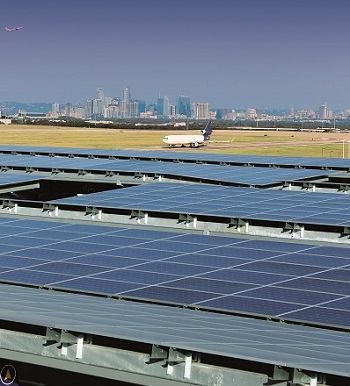
By Bee Thompson, Spring 2022 Environmental Clinic Student
On March 22, 2022, Governor Kathy Hochul announced that New York has over 1 gigawatt of installed community solar capacity, making it the first state to reach this milestone. This achievement will help the state reach its clean and renewable energy goals and is notable because the state more than doubled its 2020 installed capacity of 414 megawatts.
Massachusetts and Minnesota are two other states leading the way when it comes to installing community solar projects. By the fourth quarter of 2021, Massachusetts had 641 megawatts of operational capacity, up from 555 megawatts in 2020. By February 2022, community solar in Minnesota hit 830 megawatts of capacity, up from 789 megawatts in 2020.
Community solar is a term used to describe “local solar facilities shared by multiple community subscribers who receive credit on their electricity bills for their share of the power produced.” Community solar programs allow for community members to participate in their energy future, which is especially beneficial for those who are unable install solar panels on their roofs, such as those who live in apartments or cannot afford the initial investment. While the transition to renewable energy has been pushed by different states’ clean energy standards and renewable portfolio standards, the community solar market specifically has benefitted from solar-specific subgoals in some of these programs. For example, Massachusetts’ Renewable Portfolio Standard required installation of 1,600 megawatts of solar by 2020, with credits specifically for facilities under six megawatts. However, some programs, like the one in Massachusetts, also have caps that limit the growth of community solar overall.
Community solar has also grown in response to other policies, such as net metering. Net metering is a common policy where customers with distributed solar generation pay for their net electricity use – so if the solar project is producing more electricity than the household is using, thereby adding extra electricity to the grid, the household’s electricity meter essentially “runs backward.” However, debates around community solar (and distributed solar, generally) center on appropriate pricing. While distributed energy resources benefit from net metering policies, some advocates for energy justice argue that net metering policies are regressive. Advocates argue that net metering policies are regressive because higher-income householders are typically the ones able to install rooftop solar and benefit from net metering whereas lower-income ratepayers, who are still dependent solely on the grid for their electricity, end up having to split the costs of maintaining the grid between fewer ratepayers. While this impact on ratepayers is currently minimal because of low levels of rooftop solar penetration, Shelley Welton, an Associate Professor at the University of South Carolina School of Law, notes that these policies will likely need to change in the future to address these concerns. Additionally, some markets are considering implementing value of solar tariffs over net metering policies, which take into account and aim to quantify varying costs and benefits not accounted for in net metering policies, such as environmental benefits and avoided costs from not having to invest in new generation projects.
Community solar projects have the potential to not only help states reach their renewable or clean energy targets but also to help achieve energy justice. This is especially true if environmental justice communities are given priority in their ability to access these programs. For example, Austin Energy has a community solar program currently supported by three solar project sites, with a certain amount of the program reserved for qualifying customers, including low-income customers. Additionally, experts in the energy space strongly encourage providing for community engagement and participation in these choices regarding each community’s energy future. Welton states that community empowerment is an important result of community involvement and that the energy choices a community makes can reflect values not always captured in pricing. Additionally, activist Shalanda Baker, author of Revolutionary Power, encourages social justice and civil rights groups to engage in the energy conversation and to educate community members, because energy is so intertwined with these other issues.
As the energy transition continues and states and other actors work to achieve renewable and clean energy goals, keeping these environmental justice issues at the center of the conversation and working to engage communities and social justice and civil rights groups in a meaningful way is important to ensure that it is a just transition for everyone.
The articles published on this site reflect the views of the individual authors only. They do not represent the views of the Environmental Clinic, The University of Texas School of Law, or The University of Texas at Austin.
